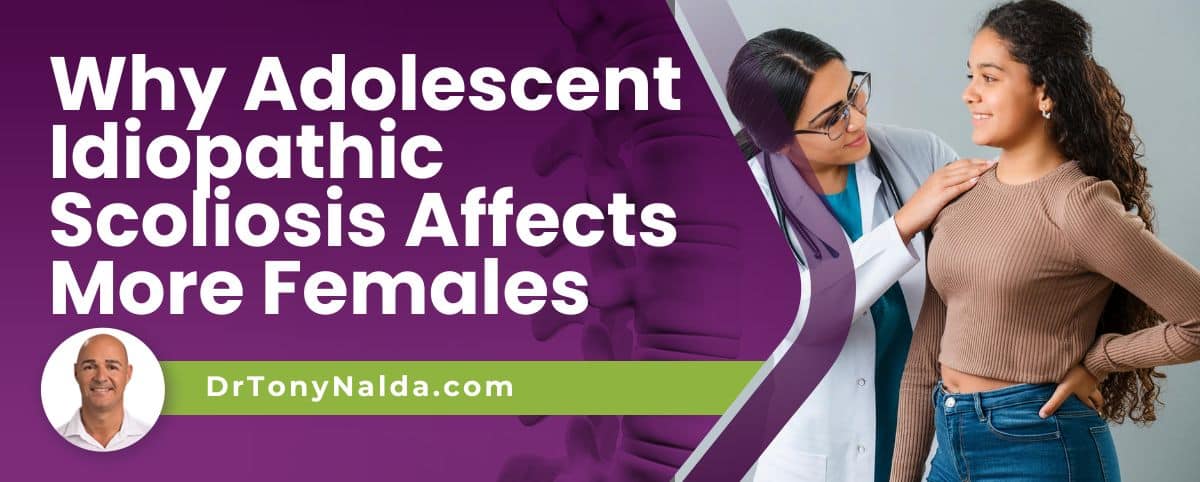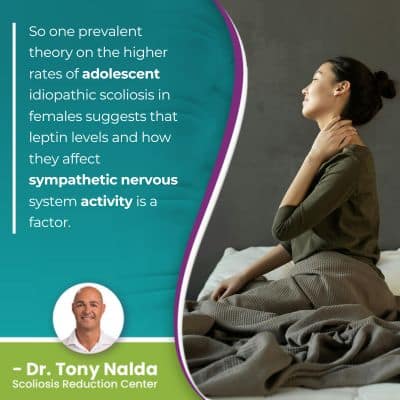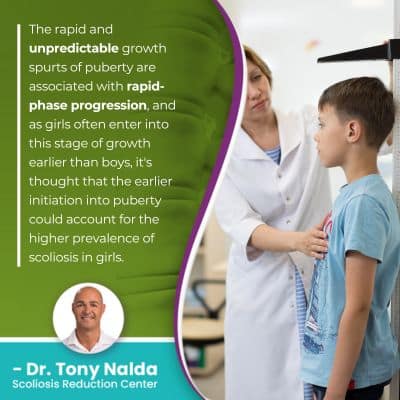Why Adolescent Idiopathic Scoliosis Affects More Females

Scoliosis has been around since ancient times, yet there is still a lot we don't know about the condition; causation is the biggest mystery. Idiopathic scoliosis, the most prevalent type, has no single-known cause, but we know it's growth that triggers progression, it's more common in females, and females are also more likely to progress.
There are a number of theories regarding the prevalence of scoliosis in females, including hormones and the earlier start of puberty; as scoliosis progression is triggered by growth, this could also be a factor in causation. Adolescent idiopathic scoliosis is thought to be multifactorial.
There are a number of factors we don't fully understand about scoliosis, and the most significant involves causation, so let's start there.
Table of Contents
What Causes Scoliosis to Develop?
When scoliosis is first diagnosed, part of the process involves further classifying conditions based on important patient and condition variables, one of which is condition type, and type is determined by causation.
Scoliosis causes an unnatural sideways-bending and rotating spinal curvature to develop, and this introduces a lot of uneven forces to the spine, its surrounding muscles, nerves, and the entire body.
There are three main spinal sections, and scoliosis can develop in any one section, or in more than one as a combined scoliosis: the cervical spine, thoracic spine, and the lumbar spine.
There are different types of scoliosis, but the most prevalent type to affect all ages is idiopathic scoliosis, and idiopathic means not clearly associated with a single-known cause.
Idiopathic scoliosis is thought to be multifactorial: caused by a number of factors, or a combination of certain factors, that can vary from person to person.
Idiopathic scoliosis isn't always easy to diagnose as scoliosis ranges widely in severity from mild scoliosis to moderate, severe and very severe scoliosis.
Idiopathic scoliosis accounts for approximately 80 percent of known cases, and the remaining 20 percent have known causes: neuromuscular scoliosis, degenerative scoliosis, and congenital scoliosis.
Neuromuscular scoliosis is caused by the presence of a larger neuromuscular condition such as spina bifida, muscular dystrophy, or cerebral palsy, to name a few.
Degenerative scoliosis affects older adults and is caused by natural age-related spinal degeneration, coupled with the cumulative effect of certain lifestyle factors: weight, activity level, posture, etc.
Congenital scoliosis is a rare type, affecting approximately 1 in 10,000, and is caused by a malformed spine that develops in utero.
An interesting fact about scoliosis causation is that it's more common in females than in males, and in addition, scoliosis in females is more likely to continue progressing.
Adolescent Idiopathic Scoliosis in Females
 So while we don't fully understand what triggers the initial onset of idiopathic scoliosis, we know that it's growth that triggers its progression, and scoliosis progressing means the size of the unnatural spinal curve is increasing, as are the condition's uneven forces, and their effects.
So while we don't fully understand what triggers the initial onset of idiopathic scoliosis, we know that it's growth that triggers its progression, and scoliosis progressing means the size of the unnatural spinal curve is increasing, as are the condition's uneven forces, and their effects.
We also know that adolescent idiopathic scoliosis is more often diagnosed in females, and according to the American Academy of Orthopedic Surgeons, girls are 10 times more likely to develop AIS before the age of 10, and they are also 10 times more likely to experience progression than males of the same age
As is the case with understanding idiopathic scoliosis onset, there are a number of theories attempting to explain the higher prevalence of idiopathic scoliosis and progression in female adolescents, but they are just theories; two of the most accepted theories involve hormones and an earlier initiation into puberty.
Hormones and Adolescent Idiopathic Scoliosis
There are a number of theories regarding AIS that involve hormone levels, and these are connected to the function of the autonomic nervous system (ANS); the ANS directs puberty and skeletal growth through hormone levels.
Leptin is considered a master hormone that facilitates a number of regulatory functions involved in growth and reproduction.
A function of leptin is to tell the body when it's full and to stop eating, so leptin levels play important roles in body weight, bone growth, when puberty starts, and disruptions to the sympathetic nervous system, which is part of the ANS.
So one prevalent theory on the higher rates of adolescent idiopathic scoliosis in females suggests that leptin levels and how they affect sympathetic nervous system activity is a factor.
Leptin and Weight Management
There have also been a number of studies done on the role of body mass index and idiopathic scoliosis screening.
As leptin is involved in appetite control, it's involved in weight management, and there have been a number of studies exploring the higher prevalence of idiopathic scoliosis in females with a low body mass index; theories suggest that females have an altered sensitivity to the hormone making them more susceptible to developing idiopathic scoliosis and increasing activity in the sympathetic nervous system.
The increase in SNS activity is thought to be a factor in the development of AIS in a number of ways:
- Earlier development
- Increased height
- Faster rates of skeletal growth
- Contributing to skeletal length asymmetries
- Lower body mass index
It's thought that how the SNS functions affects the spine and can cause asymmetrical changes, and this can disrupt the neuroendocrine effects on adolescent spinal growth.
Other hormones have also been looked at; the role of melatonin, specifically, has been looked at but needs clearer findings.
Earlier Puberty in Females
 For females, puberty generally starts earlier, and as growth and puberty triggers progression, could there be a connection between the start of puberty and scoliosis onset?
For females, puberty generally starts earlier, and as growth and puberty triggers progression, could there be a connection between the start of puberty and scoliosis onset?
The rapid and unpredictable growth spurts of puberty are associated with rapid-phase progression, and as girls often enter into this stage of growth earlier than boys, it's thought that the earlier initiation into puberty could account for the higher prevalence of scoliosis in girls.
An earlier initiation into puberty could also explain why scoliosis is also known to progress faster in girls, but whether this is due to hormones, puberty, or the effect of hormones on the body's nervous system, or a combination of all these factors, remains unclear.
So what we do know is that idiopathic scoliosis is the most common type, but we don't know why it initially develops; we also know that adolescent idiopathic scoliosis, diagnosed between the ages of 10 and 18, is the most common form of scoliosis overall, and we know it's more commonly diagnosed in females, and also is more likely to progress in females.
What we most certainly know is how to respond to a diagnosis of adolescent idiopathic scoliosis, regardless of what triggered its initial onset; the most important decision to be made about scoliosis is how to respond to a diagnosis with treatment because it will shape the spine's long term outcomes.
Conclusion
Adolescent idiopathic scoliosis patients have a lot to deal with; on top of the regular challenges of adolescence, they have living with a progressive spinal condition to deal with.
The main effect of scoliosis in children involves postural changes, and most adolescents don't want to stick out, they want to blend in with their peers, and scoliosis causes a disruption to the body's overall symmetry.
In adults, the main effect of scoliosis is pain, and this is because scoliosis doesn't become a compressive condition until skeletal maturity has been reached.
In many cases of AIS, the earliest signs are uneven shoulders and uneven hips, and additional postural changes can include the development of a rib hump, an uneven waistline, and arms and legs that appear to hang at different lengths.
As the body's center of gravity shifts, changes to balance, coordination, and gait are also common, along with a muscle imbalance.
Most patients with AIS don't require surgical intervention, particularly with early detection and early intervention.
When it comes to managing scoliosis, being proactive is key, particularly in children as progression is caused by a growth spurt.
While there are a number of theories that attempt to account for the development of scoliosis in adolescent girls, the general consensus is that idiopathic scoliosis causation could involve a number of variables such as hormone levels, body mass index, genetic factors, and early puberty.
Here at the Scoliosis Reduction Center, regardless of condition type or severity, the best time to start treatment is always now; scoliosis gets more complex to treat the more it progresses, and when it comes to addressing AIS, a focus is on counteracting the condition's progressive nature and holding treatment results despite the constant trigger of growth.
Through a physical examination, taking a patient's family history, and magnetic resonance imaging, a patient's Cobb angle can be determined and conditions can be diagnosed, and then treatment options need to be discussed and considered.
Dr. Tony Nalda
DOCTOR OF CHIROPRACTIC
After receiving an undergraduate degree in psychology and his Doctorate of Chiropractic from Life University, Dr. Nalda settled in Celebration, Florida and proceeded to build one of Central Florida’s most successful chiropractic clinics.
His experience with patients suffering from scoliosis, and the confusion and frustration they faced, led him to seek a specialty in scoliosis care. In 2006 he completed his Intensive Care Certification from CLEAR Institute, a leading scoliosis educational and certification center.
About Dr. Tony Nalda
 Ready to explore scoliosis treatment? Contact Us Now
Ready to explore scoliosis treatment? Contact Us Now





